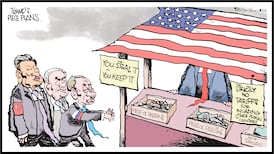In 2013, Caitlin Moran wrote a column about Starbucks becoming "a slightly shabby council facility", whose ascent coincided with 50 per cent of Britain's public toilets closing down, thus making Starbucks the de facto free jacks of a nation.
Seeing Avalon House on Aungier Street in Dublin turned into yet another Starbucks, when you wouldn't even have your takeaway coffee finished before you hit another Starbucks outlet nearby, is depressing if you care about how a city's streets look.
There are 51 Starbucks outlets in Dublin now, and they’re all the same, as they are in any city, airport, or shopping centre.
Starbucks pretty much missed the boom in Ireland.
By the time it arrived here, its brand was already jaded, a place for people to plonk themselves with their laptops on increasingly-faded interiors, or for tourists to gravitate towards something familiar.
Nevertheless, leases and rents favour top dollar, and multinational corporations benefit from head-scratching benefits that independent businesses do not.
It’s kind of like how celebrities get all the free stuff even though they’re already loaded.
Starbucks strips our streets of individuality
Starbucks paid €4,196 in corporation tax in the Republic in 2014. It paid no corporation tax for two years before that.
In 2011, it paid €34,980 in corporation tax, having paid no corporation tax since 2005. In 2016, Starbucks paid €45 in corporation tax.
Seeing Starbucks bloom in Ireland is something I’m allergic to, considering it strips our streets of individuality.
I had a chat with Colin Harmon of 3fe about the Starbucks phenomenon.
Harmon and his cafe are seen as seminal in Ireland’s contemporary cafe ecosystem.
He sees Starbucks as a meeting space. “We try not to compete with them . . . They’re almost like a hospitality company [more] than a coffee company.”
There is a Starbucks down the street from 3fe’s Grand Canal Street HQ, and it hasn’t done the business any harm.
They might both sell coffee, but what they’re offering in both product quality and ambience is very different.
Independent cafes
In tandem with Starbucks’s growth in Ireland, there has been a boom in independent cafes.
Chilled-out places with clean lines, decent (if expensive) coffee and fresh food, these cafes are the antithesis to the greasy spoon or the petrol station coffee machine.
But they aren’t immune to homogeneity either.
In fact, what is becoming apparent in cities across the world is the Starbucksification of independent cafes.
You can now predict what a new cafe will look like before it opens - the subway tiles and pale functional wooden furniture, the exposed pipes and filament lightbulbs, the avocado on sourdough bread and iPad registers, the whites and greys, the concrete.
Similar to how many new bars in Dublin look the same, as they draw inspiration and personnel from a similar design pool, after a certain point everything begins to feel like a knock-off.
Eventually, the effect is like the endlessly repetitive Chemical Brothers video for Star Guitar.
The unique identities of many cities are being drained by homogenisation.
Cafes in many cities have come to have similar design cues, and you can’t punish anyone for following trends.
If the product and ambience is good, then what’s the problem?
However, the phenomenon creates the niggling feeling that independent outlets are just as susceptible to homogeneity as high-street franchises.
“The challenge for us is to stay different,” Harmon said.
In many cases, this homogeny is superficial, because while a cafe’s aesthetic might indicate a certain standard, there may be discrepancies between such establishments when its comes to the quality of a product.
Two places can have the same “look”, yet one might only be alright while the other is great.
It’s the same thing as paying €10 for a terrible cocktail in a cool bar made by someone who is clueless when it comes to mixing a drink, and paying €12 for a great drink down the road made by someone who knows their stuff.
The €2 is worth it for the better product, yet the design of a cafe or bar can fool us into thinking both products are just as good.
Homogeneity
The homogeneity of our streets isn’t just about the mushrooming of chain outlets and what that does for choice.
It also has to do with how things look in terms of signage and shop-fronts.
The unique identities of many cities are being drained by homogenisation.
Cities are becoming interchangeable, with the same high streets, the same shops and cafes, and the same atmosphere.
When it comes to design and architecture, generic shop-fronts and chain-store signage are supplanting what is unique about how a city looks and feels.
As it stands, Dublin is beautiful from one floor up
I rang Dublin City Council’s planning office to get some information about the capital’s shop-front regulations.
The person who answered the phone said the council had only ever produced one shop-front design guide, in 2001.
However, that guide states that there was a previous one - the first - which was published in 1990.
“Dublin Corporation,” the 2001 guide states, “Is concerned . . . to further an awareness of good shop-front design.”
Concerned enough to update this document 16 years on?
The 2001 guide is a basic enough document, making soft suggestions about shop-front colour schemes being in harmony with the rest of the building, and how a good way to provide access for disabled customers is by taking away steps.
As it stands, Dublin is beautiful from one floor up.
But at eye-level, the plastic and disposable fronts of its shops and fast-food outlets gut the city of architectural and design individuality, a sea of Spar fascia and bland mobile phone logos.
Above the ground-floor on Henry Street, Grafton Street, O'Connell Street, and so on, the city is gorgeous.
Perhaps tourists should be sold stilts so they can realise they’re somewhere different. Unless, of course, they’re gagging for a pumpkin spice latte.














